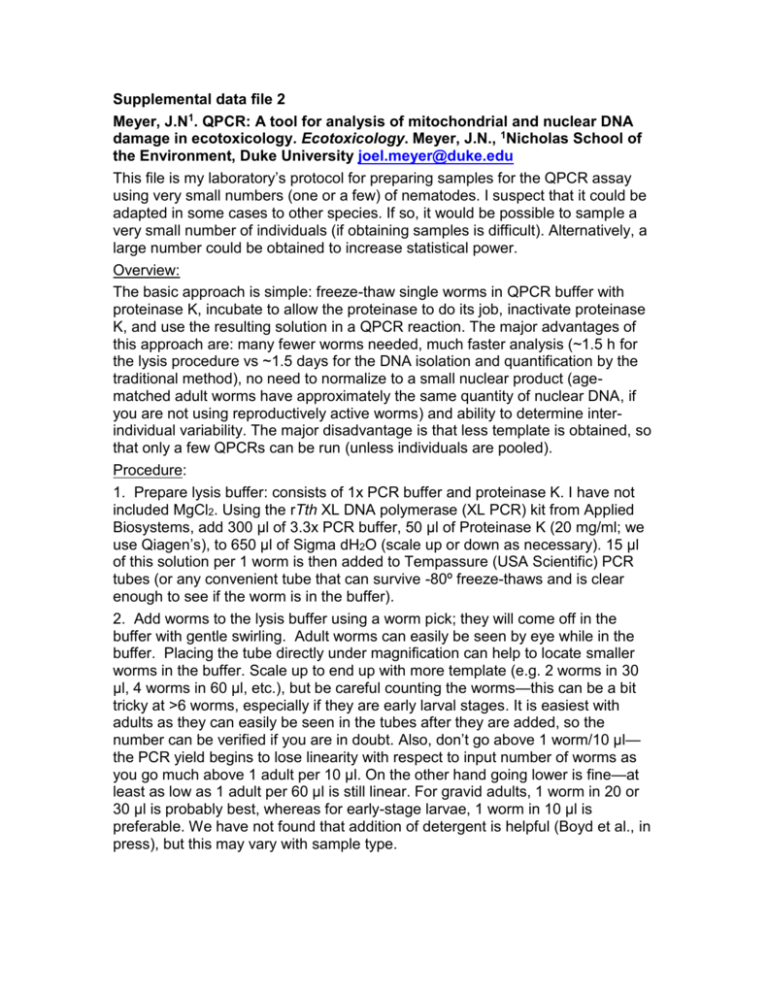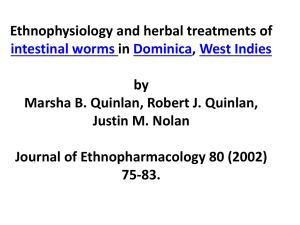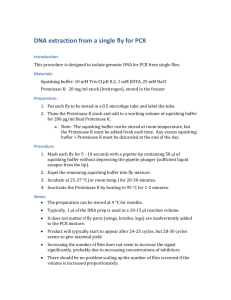10646_2009_457_MOESM2_ESM
advertisement

Supplemental data file 2 Meyer, J.N1. QPCR: A tool for analysis of mitochondrial and nuclear DNA damage in ecotoxicology. Ecotoxicology. Meyer, J.N., 1Nicholas School of the Environment, Duke University joel.meyer@duke.edu This file is my laboratory’s protocol for preparing samples for the QPCR assay using very small numbers (one or a few) of nematodes. I suspect that it could be adapted in some cases to other species. If so, it would be possible to sample a very small number of individuals (if obtaining samples is difficult). Alternatively, a large number could be obtained to increase statistical power. Overview: The basic approach is simple: freeze-thaw single worms in QPCR buffer with proteinase K, incubate to allow the proteinase to do its job, inactivate proteinase K, and use the resulting solution in a QPCR reaction. The major advantages of this approach are: many fewer worms needed, much faster analysis (~1.5 h for the lysis procedure vs ~1.5 days for the DNA isolation and quantification by the traditional method), no need to normalize to a small nuclear product (agematched adult worms have approximately the same quantity of nuclear DNA, if you are not using reproductively active worms) and ability to determine interindividual variability. The major disadvantage is that less template is obtained, so that only a few QPCRs can be run (unless individuals are pooled). Procedure: 1. Prepare lysis buffer: consists of 1x PCR buffer and proteinase K. I have not included MgCl2. Using the rTth XL DNA polymerase (XL PCR) kit from Applied Biosystems, add 300 µl of 3.3x PCR buffer, 50 µl of Proteinase K (20 mg/ml; we use Qiagen’s), to 650 µl of Sigma dH2O (scale up or down as necessary). 15 µl of this solution per 1 worm is then added to Tempassure (USA Scientific) PCR tubes (or any convenient tube that can survive -80º freeze-thaws and is clear enough to see if the worm is in the buffer). 2. Add worms to the lysis buffer using a worm pick; they will come off in the buffer with gentle swirling. Adult worms can easily be seen by eye while in the buffer. Placing the tube directly under magnification can help to locate smaller worms in the buffer. Scale up to end up with more template (e.g. 2 worms in 30 µl, 4 worms in 60 µl, etc.), but be careful counting the worms—this can be a bit tricky at >6 worms, especially if they are early larval stages. It is easiest with adults as they can easily be seen in the tubes after they are added, so the number can be verified if you are in doubt. Also, don’t go above 1 worm/10 µl— the PCR yield begins to lose linearity with respect to input number of worms as you go much above 1 adult per 10 µl. On the other hand going lower is fine—at least as low as 1 adult per 60 µl is still linear. For gravid adults, 1 worm in 20 or 30 µl is probably best, whereas for early-stage larvae, 1 worm in 10 µl is preferable. We have not found that addition of detergent is helpful (Boyd et al., in press), but this may vary with sample type. 3. Immediately following the isolation of worms in the buffer, freeze the sample at -80ºC or lower for at least 10 minutes before the next step. I do not allow the worms to sit in the buffer at room temperature for more than 5 minutes before freezing. Flash-freezing in liquid nitrogen is not necessary—I have always just placed the tubes without any insulation into a -80ºC freezer. If the -80ºC freezer is not nearby, place tubes on dry ice after adding the worms, and then move them all to the -80ºC freezer when you have finished. If not proceeding directly to the next step it is possible to keep the samples frozen at -80ºC for months at least. 4. The samples then should be heated for five minutes, quickly vortexed at high speed for 4-5 seconds, and then heated for an additional 55 minutes, at 65ºC (optimal temperature for Proteinase K). The samples should then be heated to 95ºC (15 minutes) to deactivate the Proteinase K and then cooled to around 4ºC. We use a thermocycler for this step. The DNA “isolated” is used immediately for PCR, or stored at 4ºC short term (a week or two)/-80ºC long-term. Typically, with this protocol (1 worm/15 ul lysis buffer), 6-7 cycles more are needed than with our typical QPCR using 10 ng of starting genomic DNA as template, in order to get a good amount of product. Hints: L1s are a bit harder to pick and count as effectively—here it may be useful to use the small nuclear product for normalization purposes. Or, use a COPAS Biosorter to count and dispense. The small nuclear product is also required for gravid adults since egg number can vary, and is generally a good idea in any case for quality control. Carrying out the PCR reaction in a quantitative fashion and calculating the results will be much easier if you can get at least a very similar number of worms in each tube (if getting an identical number is too hard).








